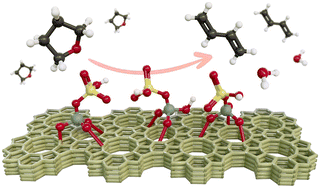Renewable 1,3-butadiene (1,3-BD, C4H6) was synthesized from the tandem decyclization and dehydration of biomass-derived tetrahydrofuran (THF) on weak Brønsted acid zeolite catalysts. 1,3-BD is a highly solicited monomer for the synthesis of rubbers and elastomers. Selective conversion of THF to 1,3-BD was recently measured on phosphorus-modified siliceous zeolites (P-zeosils) at both high and low space velocities, albeit with low per-site catalytic activity. In this work, we combined kinetic analyses and QM/MM calculations to evaluate the interaction of THF with the various Brønsted acid sites (BAS) of Boric (B), Phosphoric (P), and Sulfuric (S) acid modified silicalite-1 catalysts toward a dehydra-decyclization pathway to form 1,3-BD. Detailed kinetic measurements revealed that all three catalysts exhibited high selectivity to 1,3-BD ca. 64–96% in the order of S-MFI > P-MFI > B-MFI at a given temperature (360 °C). Notably, the S-MFI maintained a selectivity >90% for all evaluated process conditions. The computational results suggested that the nature of the Brønsted acid sites and the adsorption energetics (relative THF-acid site interaction energies) are distinct in each catalyst. Additionally, the protonation of THF can be improved with the addition of a water molecule acting as a proton shuttle, particularly in S-MFI. Overall, S-containing zeosils exhibited the ability to control reaction pathways and product distribution in dehydra-decyclization chemistry optimization within microporous zeolites, providing another alternative weak-acid catalytic material.
